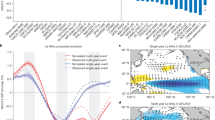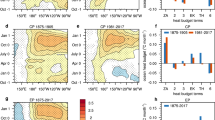Abstract
El Niño events are a prominent feature of climate variability with global climatic impacts. The 1997/98 episode, often referred to as ‘the climate event of the twentieth century’1,2, and the 1982/83 extreme El Niño3, featured a pronounced eastward extension of the west Pacific warm pool and development of atmospheric convection, and hence a huge rainfall increase, in the usually cold and dry equatorial eastern Pacific. Such a massive reorganization of atmospheric convection, which we define as an extreme El Niño, severely disrupted global weather patterns, affecting ecosystems4,5, agriculture6, tropical cyclones, drought, bushfires, floods and other extreme weather events worldwide3,7,8,9. Potential future changes in such extreme El Niño occurrences could have profound socio-economic consequences. Here we present climate modelling evidence for a doubling in the occurrences in the future in response to greenhouse warming. We estimate the change by aggregating results from climate models in the Coupled Model Intercomparison Project phases 3 (CMIP3; ref. 10) and 5 (CMIP5; ref. 11) multi-model databases, and a perturbed physics ensemble12. The increased frequency arises from a projected surface warming over the eastern equatorial Pacific that occurs faster than in the surrounding ocean waters13,14, facilitating more occurrences of atmospheric convection in the eastern equatorial region.
This is a preview of subscription content, access via your institution
Access options
Subscribe to this journal
Receive 12 print issues and online access
$209.00 per year
only $17.42 per issue
Buy this article
- Purchase on Springer Link
- Instant access to full article PDF
Prices may be subject to local taxes which are calculated during checkout




Similar content being viewed by others
References
Changnon, S. A. El Niño, 1997–1998: The Climate Event of the Century (Oxford Univ. Press, 2000).
McPhaden, M. J. El Niño: The child prodigy of 1997–98. Nature 398, 559–562 (1999).
Philander, S. G. H. Anomalous El Niño of 1982–83. Nature 305, 16 (1983).
Glynn, P. W. & de Weerdt, W. H. Elimination of two reef-building hydrocorals following the 1982–83 El Niño. Science 253, 69–71 (1991).
Aronson, R. B. et al. Coral bleach-out in Belize. Nature 405, 36 (2000).
Wilhite, D. A., Wood, D. A. & Meyer, S. J. in Climate Crisis (eds Glantz, M., Katz, R. & Krenz, M.) 75–78 (UNEP, 1987).
Vos, R., Velasco, M. & Edgar de Labastida, R. Economic and social effects of El Niño in Ecuador, 1997–1998 (Inter-American Development Bank, Sustainable Development Dept. Technical papers series POV-107, 1999).
Vincent, E. M. et al. Interannual variability of the South Pacific Convergence Zone and implications for tropical cyclone genesis. Clim. Dynam. 36, 1881–1896 (2011).
Cai, W. et al. More extreme swings of the South Pacific convergence zone due to greenhouse warming. Nature 488, 365–369 (2012).
Meehl, G. et al. The WCRP CMIP3 multimodel dataset: A new era in climate change research. Bull. Am. Meteorol. Soc. 88, 1383–1394 (2007).
Taylor, K. E., Stouffer, R. J. & Meehl, G. A. An overview of CMIP5 and the experimental design. Bull. Am. Meteorol. Soc. 93, 485–498 (2012).
Collins, M. et al. A comparison of perturbed physics and multi-model ensembles: Model errors, feedbacks and forcings. Clim. Dynam. 36, 1737–1766 (2011).
Xie, S. P. et al. Global warming pattern formation: Sea surface temperature and rainfall. J. Clim. 23, 966–986 (2010).
Tokinaga, H., Xie, S-P., Deser, C., Kosaka, Y. & Okumura, Y. M. Slowdown of the Walker circulation driven by tropical Indo-Pacific warming. Nature 491, 439–443 (2012).
Valle, C. A. et al. The Impact of the 1982–1983 E1 Niño-Southern Oscillation on Seabirds in the Galapagos Islands, Ecuador. J. Geophys. Res. 92, 14437–14444 (1987).
Merlen, G. The 1982–1983 El Niño: Some of its consequences for Galapagos wildlife. Oryx 18, 210–214 (1984).
Sponberg, K. Compendium of Climatological Impacts, University Corporation for Atmospheric Research Vol. 1 (National Oceanic and Atmospheric Administration, Office of Global Programs, 1999).
Timmermann, A. et al. Increased El Niño frequency in a climate model forced by future greenhouse warming. Nature 398, 694–697 (1999).
Collins, M. et al. The impact of global warming on the tropical Pacific Ocean and El Niño. Nature Geosci. 3, 391–397 (2010).
Yeh, S-W. et al. El Niño in a changing climate. Nature 461, 511–514 (2009).
Kug, J-S., An, S. I., Ham, Y. G. & Kang, I-S. Changes in El Niño and La Niña teleconnection over North Pacific–America in the global warming simulations. Theor. Appl. Climatol. 100, 275–282 (2010).
Rayner, N. A. et al. Global analyses of sea surface temperature, sea ice, and night marine air temperature since the late nineteenth century. J. Geophys. Res. 108, 4407 (2003).
Adler, R. F. et al. The Version-2 Global Precipitation Climatology Project (GPCP) Monthly Precipitation Analysis (1979–present). J. Hydrometeorol. 4, 1147–1167 (2003).
Ashok, K., Behera, S. K., Rao, S. A., Weng, H. & Yamagata, T. El Niño Modoki and its possible teleconnection. J. Geophys. Res. 112, C11007 (2007).
Lengaigne, M. & Vecchi, G. A. Contrasting the termination of moderate and extreme El Niño events in coupled general circulation models. Clim. Dynam. 35, 299–313 (2010).
Chiodi, A. M. & Harrison, D. E. Characterizing warm-ENSO variability in the equatorial Pacific: An OLR perspective. J. Clim. 23, 2428–2439 (2010).
Austin, P. C. Bootstrap methods for developing predictive models. Am. Stat. 58, 131–137 (2004).
Kim, D. et al. El Niño–Southern Oscillation sensitivity to cumulus entrainment in a coupled general circulation model. J. Geophys. Res. 116, D22112 (2011).
Johnson, N. C. & Xie, S-P. Changes in the sea surface temperature threshold for tropical convection. Nature Geosci. 3, 842–845 (2010).
Vecchi, G. A. & Soden, B. J. Global warming and the weakening of the tropical circulation. J. Clim. 20, 4316–4340 (2007).
Acknowledgements
W.C., S.B. and P.v.R. are supported by the Australian Climate Change Science Program. W.C. is also supported by Goyder Research Institute, the CSIRO Office of Chief Executive Science Leader award, and Pacific Australia Climate Change Science Adaptation Programme. M.J.M. is supported by NOAA; PMEL contribution 4049. M.C. is supported by the NERC SAPRISE project (NE/I022841/1); A.T. is supported by NSF grant number 1049219; M.H.E. and A.S., by a grant under the ARC Laureate Fellowship scheme (FL100100214); L.W. by China National Natural Science Foundation Key Project(41130859); and E.G. by Agence Nationale pour la Recherche projects ANR-10-Blanc-616 METRO.
Author information
Authors and Affiliations
Contributions
W.C. conceived the study in discussion with M.L. and G.V., and wrote the initial draft of the paper. S.B., P.v.R. and G.W. performed the analysis. M.C. conducted the perturbed physics ensemble climate change experiments with the HadCM3 model. All authors contributed to interpreting results, discussion of the associated dynamics, and improvement of this paper.
Corresponding author
Ethics declarations
Competing interests
The authors declare no competing financial interests.
Supplementary information
Rights and permissions
About this article
Cite this article
Cai, W., Borlace, S., Lengaigne, M. et al. Increasing frequency of extreme El Niño events due to greenhouse warming. Nature Clim Change 4, 111–116 (2014). https://doi.org/10.1038/nclimate2100
Received:
Accepted:
Published:
Issue Date:
DOI: https://doi.org/10.1038/nclimate2100
This article is cited by
-
Weather-dependent changes in habitat use by Alpine chamois
Movement Ecology (2024)
-
A marine heatwave drives significant shifts in pelagic microbiology
Communications Biology (2024)
-
A distinct and reproducible teleconnection pattern over North America during extreme El Niño events
Scientific Reports (2024)
-
Emergent climate change patterns originating from deep ocean warming in climate mitigation scenarios
Nature Climate Change (2024)
-
El Niño Effects and Biological Parameter Comparisons of an Estuarine Resident Fish Occurring in the Sea
Estuaries and Coasts (2024)



